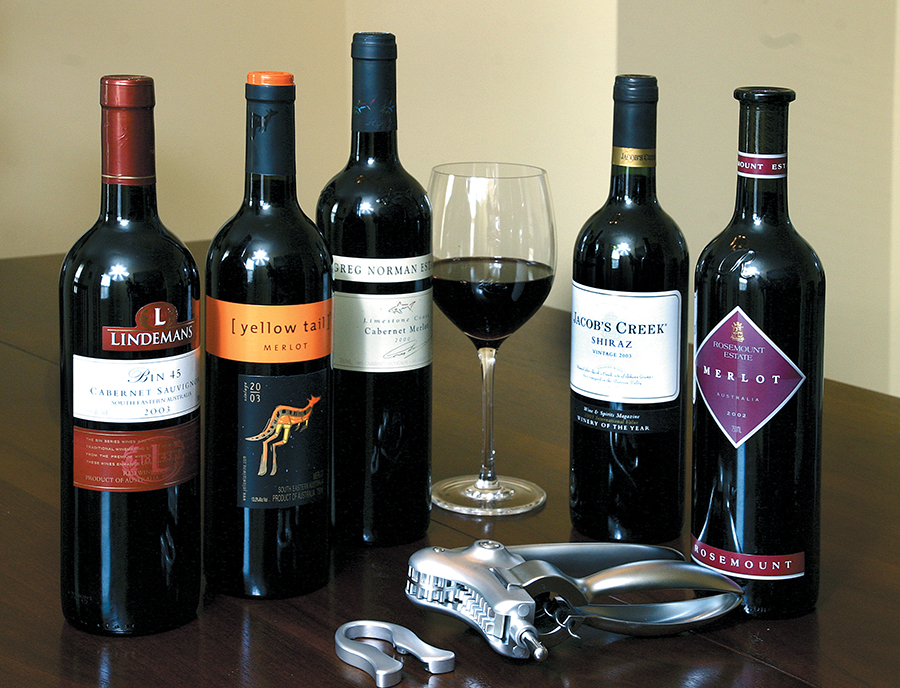By Matthew DeBord
HQ 54 | WINTER 2005
Right now, it would be tough to argue that Australia isn’t offering the best red-wine values out there. This is impressive, and possibly part of a vast plan for wine-world domination, put together by our friends Down Under.
Take Yellow Tail, the most successful story in the history of wine imports. Yellow Tail is produced by Casella Estates, a very large Aussie winemaking concern that, in less than a decade, has grown the brand into one that almost everyone in America who drinks wine has at least spotted on the shelves of a wine store. With its snappy, colorful labels, adorned with a kangaroo, Yellow Tail is ubiquitous.
It’s also pretty good, and evidence of a trend among large-scale Australian wine producers: create a high quality varietal wine (Chardonnay, Merlot, Cabernet, Shiraz), price it reasonably, and the market will beat a path to your door. For my money, the Yellow Tail reds are dandy everyday drinkers, especially the plush, mellow Merlot, with its gobs of juicy, delicious fruit, and the somewhat more complex Shiraz.
They are also a sign of the times: What people want to drink in red wine these days is being supplied, more and more, by Australia, not France or California.
How did this happen? Well, for starters, it’s not as if Australia doesn’t produce some whopper reds, at steep prices, that are competitive with the best Bordeaux and Napa can crank out. To the contrary, “Oz” — as it’s often jokingly called — has a long and illustrious history of crafting phenomenal reds, going all the way back to Penfold’s Grange, the nation’s most celebrated red wine (it routinely commands $100 and more per bottle on release). In the past few decades, dozens of high-end Aussie reds have defined a new style in winemaking: hedonistic, powerful, rich, and — the truth be told — more than a little high in alcohol. Some folks don’t care for this style (they’re mostly stuffy Europhiles who mistily recall the days when most of the world’s great red wines actually tasted crummy five out of ten vintages). But I love it. And what’s not to love? It’s not clear that any of the New Age wines are going to age more than a decade, but so what? They’re so complex, rich and pleasurable when young that it’s not necessary to dig a cave in your backyard to lay them down until you’re too old to enjoy them, anyway.
As Australia developed this large-and-in-charge style, the country also thought progressively about using what it had learned to begin a domination of the low-end of the market. Now, 20 years later, Oz has bumped France off the shelves at most places in Britain, and is starting to pose a legitimate threat to California in the U.S.
Basically, all “bargain” wines produced in Australia are what I call “techno wines.” That is, they are produced from fruit sourced from all over the country’s best vineyard regions, then made into wine using the latest in technology. The result is dependable quality and high volume. Technology is the key, of course; it allows Aussie winemakers to keep their costs down.
Nowhere is this more evident than in the country’s host of excellent, affordable red wines. Yellow Tail is just the most recent example. Anyone who has ducked into a wine shop or strolled through the wine section of their local grocery store is familiar with Rosemount’s red blends. Try the Cabernet-Merlot if you want something rich and plummy, or the Cab-Shiraz is something more rustic and wild if that strikes your fancy. Both wines are routinely priced under $10. These are really superb everyday reds, as good with a simple bowl of pasta with a red sauce as they are with a takeout pizza. It’s worth it to buy them in 1.5-liter bottles and keep a case around the house for parties. To the wine snob, Rosemount red blends taste too sweet, but only a wine snob is ever going to have a problem with luscious, inexpensive reds that taste sweet. If a tad more complexity is what you desire, you can seek out Rosemount’s famous Black Diamond Shiraz, always a winner, or their GSM bottling, a blend of Grenache, Shiraz and Mourvedre that achieves a close approximation of a wine from France’s Rhone.
Another label to look for is Jacob’s Creek. I like the ShirazCabernet blend (in fact, I tend to prefer Shiraz-Cab blends overall when dealing with budget Aussie reds, as I don’t think Merlot does as well Down Under). A real selling point for Jacob’s Creek is its presence at most grocery stores across the nation.
Among the biggest wine exporters in Australia is Lindemans. Their reds were some of the first to appear in the United States, giving us all a clue as to what might be in store from Oz, in terms of both quality and price. The so-called “Bin Series” wines are worth seeking out, especially the Bin 50 Shiraz and the Bin 45 Cabernet. Once again, these are not stunningly complicated wines, but when it comes to this genre of winemaking, complexity is not the goal. A simple, happy quaff, with barbecue or burgers, is.
No discussion of the Aussie red wine phenomenon would be complete without a nod to Greg Norman. The professional golfer got into winemaking about a decade ago, and ever since has offered a steady stream of excellent reds that are a cut above the competition, quality-wise. Look for the Limestone Coast Cabernet Merlot, a deft red blend that delivers considerable bang for the buck. That robust, rough-and-tumble character that you might find in Greg Norman Estates’ Reserve Shiraz isn’t present, but the Cab Merlot is quite refined for the price, and it makes an excellent companion for everything from roasted lamb to grilled chicken.
Bottom line? The Aussies are coming. No wait, check that. They’re already here.





